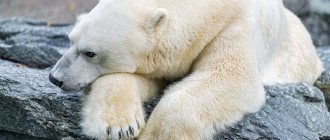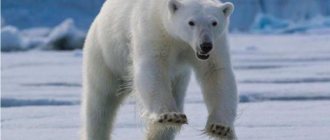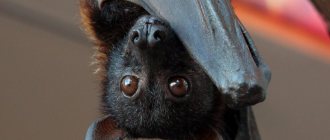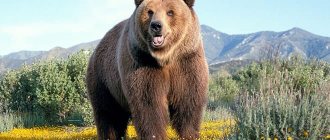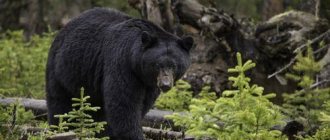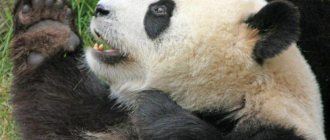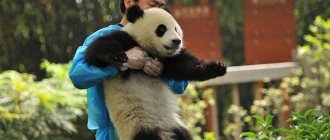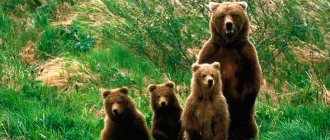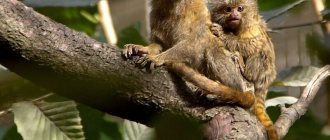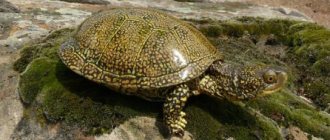№5
In 2004, an unconscious bear was found near a refrigerator with beer in the United States. He broke the refrigerator and took out metal cans of beer. Using his claws, he opened the beer and tasted it. Although he tried several types of beer, he subsequently chose only one brand and drank that beer until he lost consciousness.
Bears have canine roots
The fossil record of bears in North America and Eurasia extends back to the early Miocene. It is believed that bears came to Africa at the end of the Miocene, and to South America in the early Pleistocene.
The bear family is a recently emerged lineage of carnivores. Its ancestral line appears to have diverged from the Canidae family in the late Miocene and evolved into modern species through Pliocene forms such as borophages. Mitochondrial DNA studies conducted at the beginning of the 21st century showed that black and brown bears diverged to different parts of the world approximately 4-5 million years ago, at the beginning of the Pliocene era. The youngest species is considered to be the polar bear, which separated from the brown species approximately 200 thousand years ago.
There has been much disagreement in the scientific community regarding the classification of giant pandas (bamboo bears). Mammologists have linked giant pandas to bears (family Ursidae), raccoons (Procyonidae) or the red panda (Ailurus fulgens). However, molecular analysis conducted in the 1990s revealed a close evolutionary relationship between giant pandas and the bear family.
Photo: Yu Wang
№16
During one pregnancy, a female can carry from one to six babies. Mama bear is famous for her good attitude towards her offspring and is ready for aggressive actions, including dying for her children if they are in danger. Mothers raise their children until they are able to fend for themselves and learn to hunt well. Grizzly bear children stay close to them the longest. They can take care of their offspring until they reach 3 years of age.
We recommend reading: Interesting facts about foxes
The bear is a plantigrade animal
Unlike cats and canids, such as dogs and wolves, bears walk in a plantigrade manner (stepping on a full foot, with their heels touching the ground). All species have strong, backward-curved, non-retractable claws. The claws on the front feet are usually better developed than on the hind feet, and they are especially adapted for digging up small rodents or the roots of nutritious plants.
Photo: www.wildrevelation.com
Most species have bare soles, but the polar bear's feet are covered with fur, which allows the animal to walk on ice. Each paw has five toes. Bamboo bears have an extra opposable toe on their front feet, sometimes called a panda's "thumb." This is not a real finger, but an extension of the radial sesamoid bone covered by a pad. Animals use an extra “finger” to skillfully handle bamboo.
Bears are omnivorous and opportunistic
The specific types of food consumed may vary depending on habitat or season. For example, brown bears rely heavily on fruits and insect larvae throughout the year, or may actively prey on calves during the ungulate breeding season. The grizzly bear (a North American subspecies of brown bear) has become famous as a skilled fisherman, deftly catching salmon during spawning.
Photo: Getty Images
Most species will include vertebrates, carrion, honey, herbs, seeds, nuts, tubers and eggs in their diet whenever possible. Bears use their enormous strength, massive forelimbs and strong claws to tear apart logs and capture prey.
Bamboo bears eat primarily bamboo stems and shoots, but also include small vertebrates, insects and carrion in their diet. Spectacled bears are herbivores. The sloth bat (Melursus ursinus) especially enjoys raiding and destroying termite nests by sucking up adults and larvae with its funnel-shaped lips. Polar bears are the most carnivorous species. Their diet is dictated by the Arctic environment, as little vegetation grows within their range. Therefore, they hunt seals, fish, small mammals, birds and their eggs, as well as the carcasses of whales and walruses.
Binky's Attack
In May 1975, employees of the Alaska Department of Fish and Game rescued a polar bear cub that was dying of starvation. The bear was named Binky and presented to the Anchorage Zoo. Over time, he grew up and for many years was a real favorite of the townspeople and their children.
In July 1954, 29-year-old Australian Katherine Warburton, despite all the warnings of zoo staff, climbed over the fence of the enclosure to take some photographs of Binky. The bear did not like this, and he grabbed the woman by the thigh, trying to drag her deeper into the cage, but Katherine managed to escape - she escaped with a not too dangerous fracture and torn ligaments.
The unlucky tourist was incredibly lucky: Binky’s blow did not hit the femoral artery, otherwise everything could have ended much worse. Three weeks after the incident with Catherine, Binky attacked a group of teenagers who came too close to the enclosure, which made him a real celebrity, but not for long - in the summer of 1995 he died from a parasitic disease.
Hibernation
Interesting facts about bears - hibernation. Before laying down for the winter, the bear must accumulate as much fat reserve as possible. The animal chooses a place for a den especially long and meticulously. The shelter should be calm, dry, warm. The den should be located near a swamp or on the bank of a river, in windbreaks or secluded caves. Inside, the bear equips its home with soft bedding, and outside it camouflages and insulates it with tree branches. If the den is successful, the bear can use it for wintering for several years in a row.
During hibernation, the temperature of brown predators does not drop, so this custom is sometimes called winter sleep. Bears can wake up at any time in winter. Animals that are disturbed in winter can no longer fall asleep again, because they are exhausted and hungry. Such predators are called connecting rods - they wander through the forest in search of food. Since there is little food in the winter forest, bears roaming in winter can be very aggressive and pose a danger to humans.
Interestingly, not all species have the tradition of sleeping in winter. For example, polar bears never hibernate, except for pregnant females. Polar bear babies are born small, about the size of a cat. Due to the fact that they are born in snow dens, they have time to grow and strengthen in safe and comfortable conditions until warmer weather arrives. Male polar bears can also hibernate, but not for long and not every year.
Also, pandas do not hibernate, which, as a rule, live in mountainous areas, and when frost sets in, they descend from the mountains to the warmer foothills. In summer, when it is hot, pandas climb into the mountains, where the climate is cooler. But if pandas cannot escape the cold, they may fall asleep for a short period of time until the weather improves. Thus, even pandas that live in warm climates may hibernate briefly.
Big panda
One of the most beautiful species of bears lives in the mountains of the southern regions of China, mainly in the provinces of Sichuan, Shaanxi and Gansu. Giant pandas feed almost exclusively on bamboo shoots and only occasionally eat birds, rodents or carrion. Pandas spend 14 hours a day eating and almost the rest of the time sleeping.
Currently one of the rarest bear species, there are only about 1,600 giant pandas left in the wild, and environmentalists are calling on the world to help conserve these wonderful animals. The extermination of giant pandas in China is punishable by death, which in some cases is replaced by a long prison sentence.
Pandas were classified as a member of the bear family only in the 1970s, and they are one of the oldest species of mammals that have remained virtually unchanged.
Bears are polygamous animals
Puberty occurs between the ages of 3 and 6.5 years, usually later in males. Growth continues after puberty. Males may not reach their adult size until 10-11 years of age. Female bears usually reach adult size at the age of five.
Males and females usually communicate briefly during mating. Males monitor the estrus state of females in their home range and, when they become receptive, the males stay with the females for several days. Multiple matings are practiced by both sexes.
Bears breed no more than once a year, and many species breed only once every two to four years. The breeding season is usually in late spring or early summer. The male leaves the female shortly after mating and plays no role in raising the young.
Don't awaken the motherly instinct in the bear
As a rule, bears are solitary animals, and they unite in groups only to raise offspring or search for food together. Researchers of animal behavior have found that the strongest family ties are observed between mother bears and cubs: until the cubs are three years old, the mother takes care of them and seeks to protect them at all costs, therefore, as experienced hunters say, the worst thing is to meet a mother bear with cubs - maternal instinct forces the animal behaves very aggressively.
Mother bears often prefer to keep their cubs away from males, but in some cases they are forced to put up with their presence: for example, in the area of Brook Falls, female brown bears and their offspring participate in salmon fishing along with males.
Grizzly vs wolf
Grizzly bears and common wolves are direct competitors. Since ancient times, these two species have been fighting for survival with varying degrees of success. In 1995, a number of wolves were introduced into Yellowstone National Park (the territory of the states of Idaho, Montana and Fyoming), after which naturalists observed a confrontation between predators in an effort to take over the hunting grounds. This helped control the increased numbers of herbivores, and also contributed to the development of hunting skills in both wolves and grizzlies.
Grizzlies have no natural enemies except humans and tigers (there are known cases when the latter hunted adult individuals of the bear family), but often in a fight with a pack of wolves the bear prefers to retreat. The video depicts a dispute between a pack and a bear, and the clubfoot was forced to leave the battlefield.
Bear image for children
The bear can easily be called a symbol of Russia. This animal has been familiar to humans since childhood. Many fairy tales have been written about him, cartoons and feature films have been made. The very first childhood memories are associated with him:
- The toy is a plush miracle. All the cubs are very attractive in appearance. They are fluffy and touching, so every family has such a toy.
- A lullaby song that a bear sings to her son Umka, and parents sing to their children.
- Counting books and tongue twisters, jokes and riddles.
- Poems. A famous verse about a stomping bear who got a bump in the forehead and others.
- A bedtime story about a little bear who obeys his parents. And naughty children are frightened by a bear, which takes them into its den.
Olympic bear
- A bear flying over the Olympic arena in Moscow.
Bears of all types are unique creatures. In zoos, children especially gather near the enclosures where these animals live. They are not as friendly as some animals, but they are definitely amazing. It's always interesting to learn something about bears that you didn't know before.
